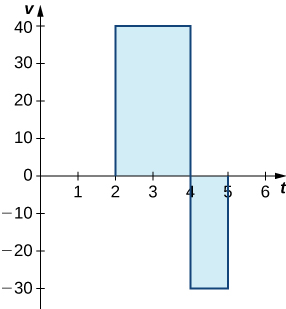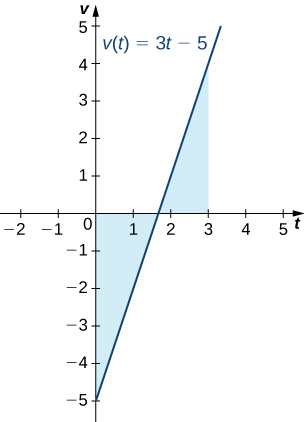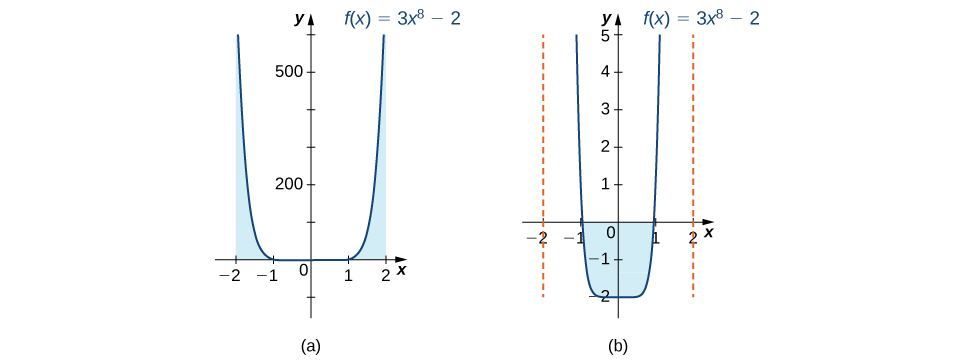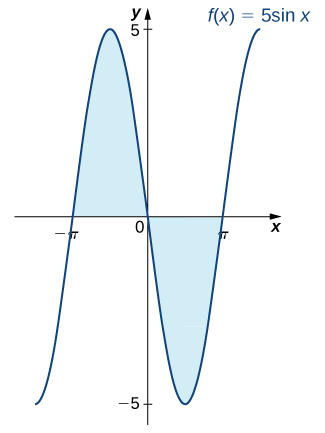5.7: Net Change
- Last updated
- Jun 6, 2019
- Save as PDF
- Page ID
- 20691
( \newcommand{\kernel}{\mathrm{null}\,}\)
In this section, we use some basic integration formulas studied previously to solve some key applied problems. It is important to note that these formulas are presented in terms of indefinite integrals. Although definite and indefinite integrals are closely related, there are some key differences to keep in mind. A definite integral is either a number (when the limits of integration are constants) or a single function (when one or both of the limits of integration are variables). An indefinite integral represents a family of functions, all of which differ by a constant. As you become more familiar with integration, you will get a feel for when to use definite integrals and when to use indefinite integrals. You will naturally select the correct approach for a given problem without thinking too much about it. However, until these concepts are cemented in your mind, think carefully about whether you need a definite integral or an indefinite integral and make sure you are using the proper notation based on your choice.
Basic Integration Formulas
Recall the integration formulas given in [link] and the rule on properties of definite integrals. Let’s look at a few examples of how to apply these rules.
Example
Use the power rule to integrate the function
Solution
The first step is to rewrite the function and simplify it so we can apply the power rule:
Now apply the power rule:
Exercise
Find the definite integral of
- Hint
-
Follow the process from Example to solve the problem.
- Answer
-
The Net Change Theorem
The net change theorem considers the integral of a rate of change. It says that when a quantity changes, the new value equals the initial value plus the integral of the rate of change of that quantity. The formula can be expressed in two ways. The second is more familiar; it is simply the definite integral.
Net Change Theorem
The new value of a changing quantity equals the initial value plus the integral of the rate of change:
or
Subtracting
The significance of the net change theorem lies in the results. Net change can be applied to area, distance, and volume, to name only a few applications. Net change accounts for negative quantities automatically without having to write more than one integral. To illustrate, let’s apply the net change theorem to a velocity function in which the result is displacement.
We looked at a simple example of this in The Definite Integral. Suppose a car is moving due north (the positive direction) at 40 mph between 2 p.m. and 4 p.m., then the car moves south at 30 mph between 4 p.m. and 5 p.m. We can graph this motion as shown in Figure.

Figure
Just as we did before, we can use definite integrals to calculate the net displacement as well as the total distance traveled. The net displacement is given by
Thus, at 5 p.m. the car is 50 mi north of its starting position. The total distance traveled is given by
Therefore, between 2 p.m. and 5 p.m., the car traveled a total of 110 mi.
To summarize, net displacement may include both positive and negative values. In other words, the velocity function accounts for both forward distance and backward distance. To find net displacement, integrate the velocity function over the interval. Total distance traveled, on the other hand, is always positive. To find the total distance traveled by an object, regardless of direction, we need to integrate the absolute value of the velocity function.
Example
Given a velocity function
Solution
Applying the net change theorem, we have
The net displacement is

Figure
Example
Use Example to find the total distance traveled by a particle according to the velocity function
Solution
The total distance traveled includes both the positive and the negative values. Therefore, we must integrate the absolute value of the velocity function to find the total distance traveled.
To continue with the example, use two integrals to find the total distance. First, find the t-intercept of the function, since that is where the division of the interval occurs. Set the equation equal to zero and solve for t. Thus,
The two subintervals are
So, the total distance traveled is
Exercise
Find the net displacement and total distance traveled in meters given the velocity function
- Hint
-
Follow the procedures from Example and Example. Note that
- Answer
-
Net displacement:
Applying the Net Change Theorem
The net change theorem can be applied to the flow and consumption of fluids, as shown in Example.
Example
If the motor on a motorboat is started at
Solution
Express the problem as a definite integral, integrate, and evaluate using the Fundamental Theorem of Calculus. The limits of integration are the endpoints of the interval [0,2]. We have
Thus, the motorboat uses 6 gal of gas in 2 hours.
Example
As we saw at the beginning of the chapter, top iceboat racers can attain speeds of up to five times the wind speed. Andrew is an intermediate iceboater, though, so he attains speeds equal to only twice the wind speed.

Figure
Suppose Andrew takes his iceboat out one morning when a light 5-mph breeze has been blowing all morning. As Andrew gets his iceboat set up, though, the wind begins to pick up. During his first half hour of iceboating, the wind speed increases according to the function
Recalling that Andrew’s iceboat travels at twice the wind speed, and assuming he moves in a straight line away from his starting point, how far is Andrew from his starting point after 1 hour?
Solution
To figure out how far Andrew has traveled, we need to integrate his velocity, which is twice the wind speed. Then
Distance =
Substituting the expressions we were given for
Andrew is 25 mi from his starting point after 1 hour.
Exercise
Suppose that, instead of remaining steady during the second half hour of Andrew’s outing, the wind starts to die down according to the function
Under these conditions, how far from his starting point is Andrew after 1 hour?
- Hint
-
Don’t forget that Andrew’s iceboat moves twice as fast as the wind.
- Answer
-
Integrating Even and Odd Functions
We saw in Functions and Graphs that an even function is a function in which
Integrals of even functions, when the limits of integration are from −a to a, involve two equal areas, because they are symmetric about the y-axis. Integrals of odd functions, when the limits of integration are similarly
Rule: Integrals of Even and Odd Functions
For continuous even functions such that
For continuous odd functions such that
Example
Integrate the even function
Solution
The symmetry appears in the graphs in Figure. Graph (a) shows the region below the curve and above the x-axis. We have to zoom in to this graph by a huge amount to see the region. Graph (b) shows the region above the curve and below the x-axis. The signed area of this region is negative. Both views illustrate the symmetry about the y-axis of an even function. We have
To verify the integration formula for even functions, we can calculate the integral from 0 to 2 and double it, then check to make sure we get the same answer.
Since

Figure
Example
Evaluate the definite integral of the odd function
Solution
The graph is shown in Figure. We can see the symmetry about the origin by the positive area above the x-axis over

Figure
Exercise
Integrate the function
- Hint
-
Integrate an even function.
- Answer
-
Key Concepts
- The net change theorem states that when a quantity changes, the final value equals the initial value plus the integral of the rate of change. Net change can be a positive number, a negative number, or zero.
- The area under an even function over a symmetric interval can be calculated by doubling the area over the positive x-axis. For an odd function, the integral over a symmetric interval equals zero, because half the area is negative.
Key Equations
- Net Change Theorem
Glossary
- net change theorem
- if we know the rate of change of a quantity, the net change theorem says the future quantity is equal to the initial quantity plus the integral of the rate of change of the quantity
Contributors
Gilbert Strang (MIT) and Edwin “Jed” Herman (Harvey Mudd) with many contributing authors. This content by OpenStax is licensed with a CC-BY-SA-NC 4.0 license. Download for free at http://cnx.org.

